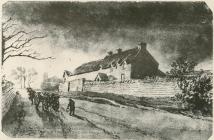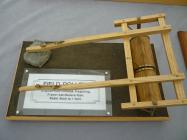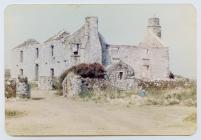Content can be downloaded for non-commercial purposes, such as for personal use or in educational resources.
For commercial purposes please contact the copyright holder directly.
Read more about the The Creative Archive Licence.
Description
There is only a short mention of this mill in "The History of the Vale of Neath" by D. Rhys Philips. It mentions that the mill dates back as early as the 16th century as a manor mill, and lasted as a three story building until the death of Miss Penrose of Clun y Bont. The mill fell out of use in the 19th century around the 1870's when the Maes Marchog collieries of Penrose ceased operation. (1)
The mill can be seen on a number of old Ordanance Survey maps and is identified as a Grist (Corn) mill on the maps.
There is a lovely little skit attached to the mill which is mentioned in the Philips book, it goes:
Mi wela Shiwan Harri..............................I saw Shiwan HarriYn prysur gasglu persli...........................Busy collecting parsleyWrth Felin Gwrach ar fin y plwyf,..........By the Gwrach Mill at the edge of the parish,Er gwella'r clwyf sydd arni. ....................To heal her wounds.
The mill was located on the land behind Calfaria Chapel, and was fed by the Gwrach brook by means of a leat which probably run from a wier on the brook just above Parry fish and chip shop.
The drawing by David Williams depicts what the Mill could have looked like before the age of photography, the mill and the row of houses in the background can be seen on the Tithe maps. I wonder what the row of houses was called? The brook at the forefront of the drawing is the Gwrach brook, Cefn Gelli would have been to the left of the drawing but is not shown.
I would like to take this opportunity to thank David for the fantastic drawing he created, I know how much time and effort he put in to getting this as accurate as possible.
If you look carefully you can see Siwan Harri picking parsley to the right of the picture between the brook and the mill.
Blaengwrach was a very agriculture landscape back in the 16th and 17th century and hopefully the drawing represents what it would have looked like back in that time.
The design of the mill shown is based on the mill which can be seen in St Fagans ~ National Museum of History, and was a very common design of Grist Mill in South Wales in the 18th century.
As I mentioned at the start of the article not much information is available regarding the mill, but if more information becomes available in the future this article will be updated accordingly.
Resources and References:
(1) The History of the Vale of Neath by D. Rhys Philips (page 222)
Drawing by David Williams, website address: https://www.davidwilliamsart.com






Do you have information to add to this item? Please leave a comment
Comments (0)
You must be logged in to leave a comment